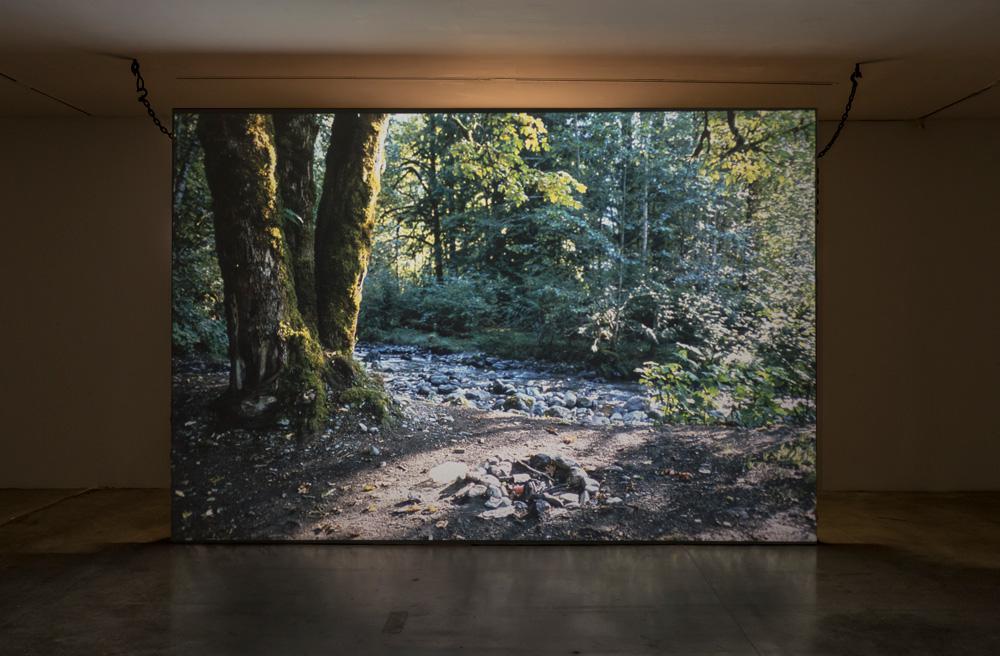British artist Mike Nelson’s show “Amnesiac Hide,” at the Power Plant in Toronto until May 19, is the kind of exhibition that serves as a catalytic agent. Drop it into the Canadian context and it produces the fizz of new ideas.
Centred on the idea of camping, of being out in nature, the show enacts a connection between the British tradition of manly outdoor pursuits and the Canadian iteration of that calling. The exhibition, which includes two major new works resulting from experiences in BC and Alberta, forms a kind of bridge between Canadian and British cultures, making explicit something that is core to Canadian life.
The quest to find a primal connection with landscape—with building fires, making shelters, finding one’s way alone—derived in settler culture from the British Romantic tradition of exaltation in nature, the pursuit of poetic souls seeking escape from the clamour and confinement of industrialization. In their tweed-jacketed, pipe-smoking excursions into the near North, the Group of Seven artists glorified that pastime, their paintings embodying the successful transplanting of that tradition from British to Canadian soil. (Both Varley and Lismer came from Sheffield, while J.E.H. Macdonald was born in Durham.) Emily Carr, a first-generation Canadian of staunchly British parentage, enacted a similar flight into nature in her famous “elephant van,” her legacy as urban refugee remembered today in the work of contemporary Canadian artists in BC like Liz Magor and Gareth Moore.
Nelson’s show reactivates this UK-Canada connection. One thread of the show has to do with the life of his friend Erlend Williamson, an outdoorsman and artist who died in a climbing accident in Scotland in 1996. On battered wooden shelving, Nelson displays Williamson’s used ropes and hiking boots, his tattered wrist cast from an earlier accident, his rock collection, detritus of his camping life, and other objects, an arrangement that evokes the squirrelly hideout of a mountain recluse.
Inspired by the slides of late anthropologist Wilson Duff at the Museum of Anthropology in Vancouver, Nelson travelled across BC, and his journey is recalled here in a slide projection that is appended to Williamson’s possessions. Among other subjects, the slides document a series of abandoned campsites and burnt-out fires that Nelson discovered along his route. The most primitive of territorial markers, such sites are a testament to man’s need to make a provisional place in the wilds; through Nelson’s lens, they read as forlorn anti-monuments to the idea of moving on. The whole ensemble is titled Eighty Circles through Canada (the last possessions of an Orcadian mountain man), its tone fittingly elegiac.
In another gallery, Nelson has assembled a group of sculptures (together called Gang of Seven) that are made from odds and ends he discovered washed up on Vancouver beaches. Some of these materials are arranged to suggest charred bonfires, ablaze with torn orange plastic flames. Other sculptures evoke human figures jerry-rigged from bits of plastic, ropes, pieces of found wood, feathers, rocks, discarded car mats, and lumps of surf-tumbled styrofoam. In a sculptural move to rival Picasso’s ingenious repurposing of a bicycle seat for a bull’s head, Nelson recycles found plastic milk jugs which, when inverted, evoke the human skull. Tellingly, most of these human forms are constructed on tires or dollies, or incorporate some other signifiers of transport. Metaphorically, they are on the move, or, at the very least, unrooted.
The theme of nomadism takes on epic and ultimately Sisyphean form, though, in Nelson’s Quiver of Arrows, for which he reconfigures four shabby vintage trailer homes into a kind of Möbius interior, the trailers joined end to end in a loop. Inside them, Nelson displays abandoned travel books, souvenir tea towels, old movie posters, scraps of notes and other sentimental bric-a-brac. The ensemble leaves us contemplating the mystique of freedom, but also the costs of rootlessness. These are lonely spaces.
Wilderness means something different in the UK than it does in Canada, where, spatially at least, nature has the undeniable upper hand. Nomadism, too, means something different now than it did a century ago, when the fast-surging innovations in travel and technology were just beginning their fearsome acceleration. Nelson’s exhibition prompts us to think about those differences, to contemplate the seductive allure of wandering and the equally alluring appeal of finding home.









